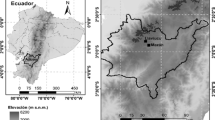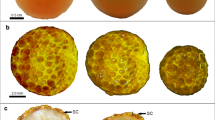Abstract
Key message
Seed banking is an essential tool for species conservation. However, two world’s biodiversity hotspots in a megadiverse tropical country have high percentage of short-lived seeds, requiring new strategies for preservation.
Abstract
Information on seed storage behaviour is crucial for conservation, especially on highly impacted biomes. Thus, this study aimed to investigate seed desiccation tolerance/sensitivity in native tree species of two world’s biodiversity hotspots, Atlantic Forest and Cerrado. We assessed seed storage behaviour for 11 species. The tests were conducted immediately after seed collection at 12% and 8–5% of water content followed by 3 months of storage at − 18 °C. In addition, we retrieved data on the literature about water content after dispersal and storage behaviour of seeds for several tree species native from these hotspots. It comprised 79 species from 30 families. From this total, 47.4% of species produced orthodox seeds, 19.2% intermediate, and 33.3% recalcitrant seeds. All species from Lauraceae produced recalcitrant seeds. Most of studied species produce long-lived orthodox seeds; however, a high percentage of species produce sensitive seeds. Species producing short-lived seeds require non-conventional storage methods. Information on seed storage behaviour is fundamental for species management, especially in tropical areas, where the number of recalcitrant species is high. Thus, seed banking and other conservation strategies must be improved to avoid species loss. Technologies to improve storage of recalcitrant seeds are discussed.




Similar content being viewed by others
References
Beech E, Rivers M, Oldfield S, Smith PP (2017) GlobalTreeSearch: the first complete global database of tree species and country distributions. J Sustain For 36:454–489
Berjak P, Pammenter NW (2008) From Avicennia to Zizania: seed recalcitrance in perspective. Ann Bot 101(2):213–228
Berjak P, Pammenter NW (2013) Implications of the lack of desiccation tolerance in recalcitrant seeds. Front Plant Sci 4:1–9
Bonner FT (1990) Storage of seeds: potential and limitations for germplasm conservation. For Ecol Manag 35:35–43
BRASIL (1992) Normais Climatológicas do Brasil, período 1961–1990. Ministério da Agricultura e da Reforma Agrária, Brasília
Carvalho LR, Da Silva EAA, Davide AC (2006) Classificação de sementes florestais quanto ao comportamento no armazenamento. Rev Bras Sem 28:15–25
Carvalho LR, Davide AC, Da Silva EAA, Carvalho MLM (2008) Classificação de sementes de espécies florestais dos gêneros Nectandra e Ocotea (Lauraceae) quanto ao comportamento no armazenamento. R Bras Sem 30:1–9
Colombo AF, Joly CA (2010) Brazilian Atlantic Forest lato sensu: the most ancient Brazilian forest, and a biodiversity hotspot, is highly threatened by climate change. Braz J Biol 70:697–708
Cromarty AS, Ellis RH, Roberts EW (1982) The design of seed storage facilities for genetic conservation. International Board for Plant Genetic Resources, Rome
Davide AC, Faria JMR, Botelho SA (1995) Propagação de espécies florestais. CEMIG/UFLA/FAEPE, Belo Horizonte
Davide AC, Carvalho LR, Carvalho MLM, Guimarães RM (2003) Classificação fisiológica de sementes de espécies florestais pertencentes à família Lauraceae quanto à capacidade de armazenamento. Cerne 9:29–35
Daws MI, Garwood NC, Pritchard HW (2006) Prediction of desiccation sensitivity in seeds of woody species: a probabilistic model based on two seed traits and 104 species. Ann Bot 97:667–674
de Lima M Jr, Hong TD, Arruda YMBC, Mendes AMS, Ellis RH (2014) Classification of seed storage behaviour of 67 Amazonian tree species. Seed Sci Technol 43:63–92
Dickie JB, Pritchard HW (2002) Systematic and evolutionary aspects of desiccation tolerance in seeds. In: Black M, Pritchard HW (eds) Desiccation and survival in plants. Drying without dying. CABI Publishing, Wallingford, pp 239–259
Ellis RH (1991) The longevity of seeds. HortScience 26:1119–1125
Farnsworth E (2000) The ecology and physiology of viviparous and recalcitrant seeds. Annu Rev Ecol Syst 31:107–138
Hong TD, Ellis RH (1996) A protocol to determine seed storage behaviour. Technical Bulletin 1, International Plant Genetic Resources Institute, Rome
Hong TD, Ellis RH (1998) Contrasting seed storage behavior among different species of Meliaceae. Seed Sci Technol 26:77–95
International Seed Testing Association (2004) International rules for seed testing. ISTA, Oftringen
José AC, Da Silva EAA, Davide AC (2007) Classificação fisiológica de sementes de cinco espécies arbóreas de mata ciliar quanto a tolerância à dessecação e ao armazenamento. Rev Bras Sem 29:171–178
Klink CA, Machado RB (2005) Conservation of the Brazilian Cerrado. Conserv Biol 19:707–713
Köppen W (1936) Das geographische system der climate. In: Köppen W, Geiger R (eds) Handbuch der klimatologie. GebruderBorntraeger, Berlin, pp 1–44
Linington SH (2003) The design of seed banks. In: Smith RD, Dickie JB, Linington SH, Pritchard HW, Probert RJ (eds) Seed conservation: turning science into practice. Royal Botanic Gardens, Kew, pp 591–636
Marques ER, Vaz TAA, Rodrigues-Junior AG, Davide AC, José AC (2017) In situ germination of two tropical recalcitrant seeds and changes in activity of ROS-scavenging enzymes. Trees 31:1785–1792
Mayrinck RC, Vaz TAA, Davide AC (2016) Physiological classification of forest seeds regarding the desiccation tolerance and storage behaviour. Cerne 22:85–92
Myers N, Mittermeier RA, Mittermeier CG, da Fonseca GAB, Kent J (2000) Biodiversity hotspots for conservation priorities. Nature 403:853–858
Nery MC, Davide AC, Da Silva EAA, Soares GCM, Nery FC (2014) Classificação fisiológica de sementes florestais quanto a tolerância à dessecação e ao armazenamento. Cerne 20:477–483
Oldfield S (2009) Botanic gardens and the conservation of tree species. Trends Plant Sci 14:581–583
Pelissari F, José AC, Fontes MA, Matos AC, Pereira WV, Faria JM (2018) A probabilistic model for tropical tree seed desiccation tolerance and storage classification. New For 49:143–158
Pritchard HW, Daws MI, Fletcher BJ, Gaméné CS, Msanga HP, Omondi W (2004) Ecological correlates of seed desiccation tolerance in tropical African dryland trees. Am J Bot 91:863–870
Pritchard HG, Moat JF, Ferraz JBS, Marks TR, Camargo JLC, Nadarajan J, Ferraz IDK (2014) Innovative approaches to the preservation of forest trees. For Ecol Manag 333:88–98
R Development Core Team (2014) R: a language and environment for statistical computing. R Foundation for Statistical Computing, Vienna. http://www.R-project.org. Accessed July 2016
Ratter JA, Ribeiro JF, Bridgewater S (1997) The Brazilian Cerrado vegetation and threats to its biodiversity. Ann Bot 80:223–230
Ribeiro GVT, Teixido AL, Barbosa NPU, Silveira FAO (2016) Assessing bias and knowledge gaps on seed ecology research: implications for conservation agenda and policy. Ecol Appl 26:2033–2043
Roberts EH (1973) Predicting the storage life of seeds. Seed Sci Technol 1:499–514
Ruane J, Sonnino A (2006) The rule of Biotechnology and in exploring and protecting agricultural genetic resources. Food and agriculture organization of the United Nations, Rome
Sherwood S, Fu Q (2014) A drier future? Science 343:737–739
Siqueira MF, Peterson AT (2003) Consequences of global climate change for geographic distributions of Cerrado tree species. Biota Neotrop 3:BN00803022003
Tabarelli M, Pinto LP, Silva JMC, Hirota MM, Bedê LC (2005) Desafios e oportunidades para a conservação da biodiversidade na Mata Atlântica brasileira. Megadiversidade 1:132–138
Teixido AL, Toorop PE, Liu U, Ribeiro GVT, Fuzessy LF, Guerra TJ, Silveira FAO (2017) Gaps in seed banking are comprimising the GSPC’s Target 8 in a megadiverse country. Biodivers Conserv 26:703–716
Thompson PA (1974) The use of seed-banks for conservation of populations of species and ecotypes. Biol Conserv 6:15–19
Tweddle JC, Dickie JB, Baskin CC, Baskin JM (2003) Ecological aspects of seed desiccation sensitivity. J Ecol 91:294–304
Van Den Berg E, Oliveira-Filho AT (2000) Composição florística e estrutura fitossociológica de uma floresta ripária em Itutinga, MG, e comparação com outras áreas. Rev Bras Bot 23:231–253
Vaz TAA, Davide AC, Rodrigues-Junior AG, Nakamura AT, Tonetti OAO, da Silva EAA (2016) Swartzia langsdorffii Raddi: morphophysiological traits of a recalcitrante seed dispersed during the dry season. Seed Sci Res 26:47–56
Vaz TAA, Rodrigues-Junior AG, Davide AC, Nakamura AT, Toorop PE (2018) A role for fruit structure in seed survival and germination of Swartzia langsdorffii Raddi beyond dispersal. Plant Biol 20:263–270
Von Teichman I, van Wyk AE (1994) Structural aspects and trends in the evolution of recalcitrant seeds in dicotyledons. Seed Sci Res 4:225–239
Walters C (2015) Orthodoxy, recalcitrance and in-between: describing variation in seed storage characteristics using threshold responses to water loss. Planta. 242(2):397–406. https://doi.org/10.1007/s00425-015-2312-6
Walters C, Berjak P, Pammenter N, Kennedy K, Raven P (2013) Preservation of recalcitrant seeds. Science 339:915–916
Acknowledgements
The authors would like to thank José Pedro for seed collection. LCV, RCM, and TMP thank PIBIC-FAPEMIG (Programa Institucional de Bolsas de Iniciação Científica da Fundação de Amparo à Pesquisa de Minas Gerais) for their scholarship. TAAV thanks CAPES (Coordenação de Aperfeiçoamento de Pessoal de Nível Superior) and FAPEMIG (Fundação de Amparo à Pesquisa de Minas Gerais) for the scholarship. ACD thanks the CNPq (Conselho Nacional de Desenvolvimento Científico e Tecnológico) for the research productivity granted.
Author information
Authors and Affiliations
Corresponding author
Ethics declarations
Conflict of interest
The authors declare that they have no conflict of interest.
Additional information
Communicated by Buckeridge.
Publisher’s Note
Springer Nature remains neutral with regard to jurisdictional claims in published maps and institutional affiliations.
Electronic supplementary material
Below is the link to the electronic supplementary material.
Rights and permissions
About this article
Cite this article
Mayrinck, R.C., Vilela, L.C., Pereira, T.M. et al. Seed desiccation tolerance/sensitivity of tree species from Brazilian biodiversity hotspots: considerations for conservation. Trees 33, 777–785 (2019). https://doi.org/10.1007/s00468-019-01815-8
Received:
Accepted:
Published:
Issue Date:
DOI: https://doi.org/10.1007/s00468-019-01815-8




